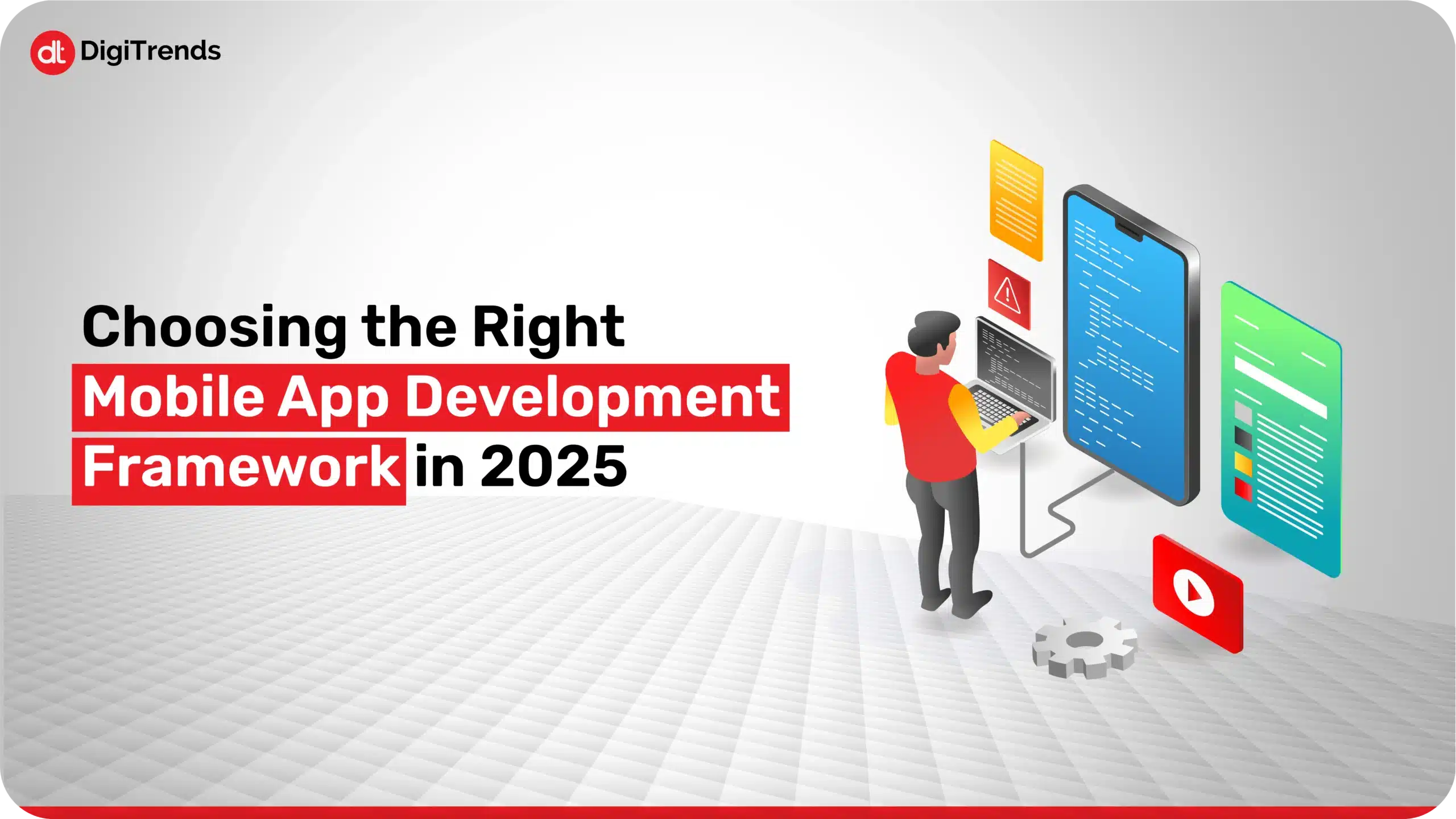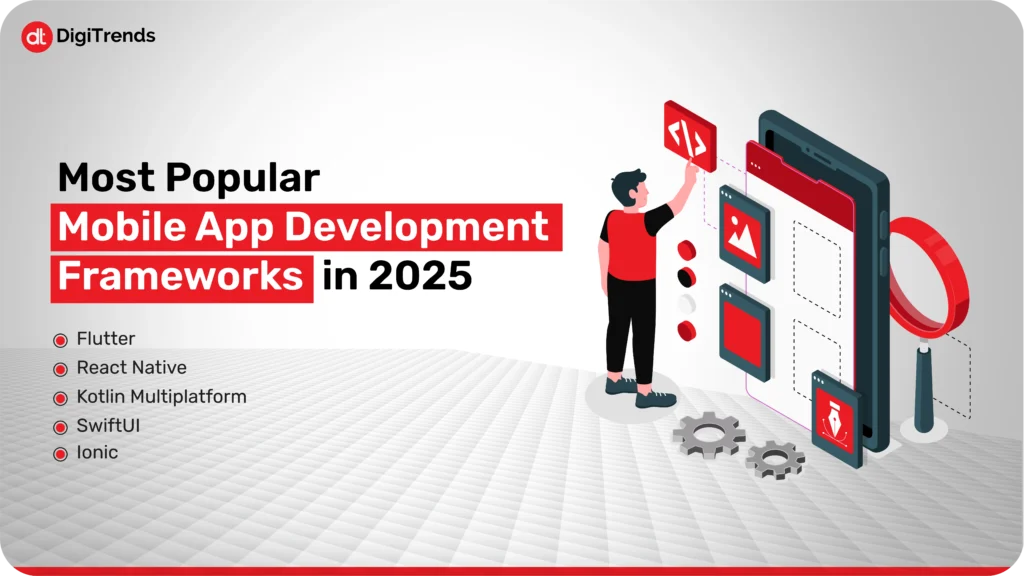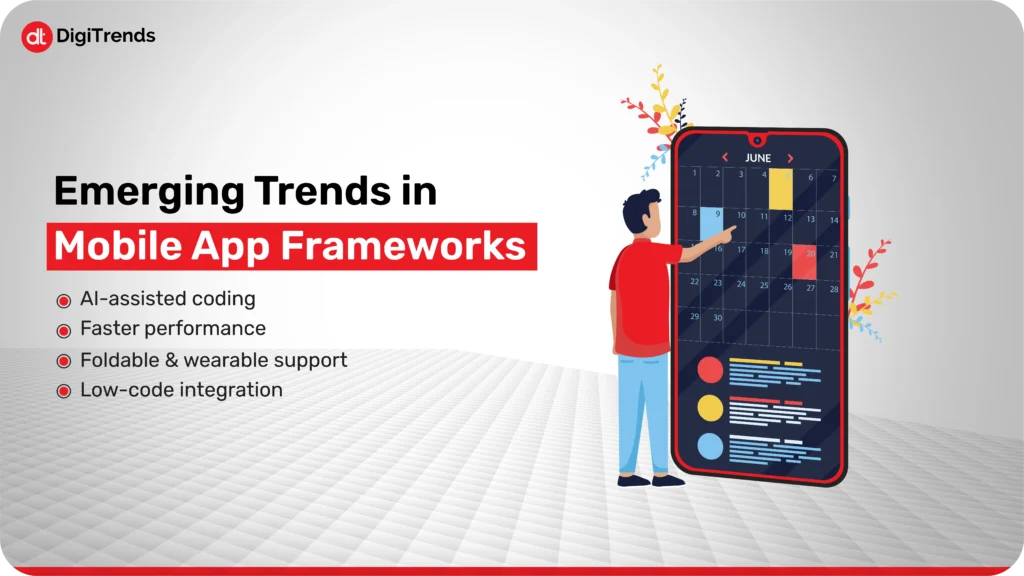
The Most Common UX Design Mistakes and How to Actually Avoid Them
Explore the most common UX design mistakes that contribute to a bad user experience and the mistakes that push users to bounce from the app.
Continue Reading
In the era of quick technology, building mobile apps has become essential for businesses rather than a luxury. A carefully chosen mobile app development framework can be the foundation of an app that transforms how a brand connects with its audience.
Choosing the right mobile app development framework should be decided before any other step. Because in 2025, users expect more, costs are on the rise, AI and AR are appearing more often in apps, your framework selection plays a big role in how fast and easily your app will be able to grow and adapt to new situations.
According to TechKV, the market forecasts indicate that the mobile app revenue will exceed $613 billion by 2025, highlighting the massive opportunity and increasing competition in the mobile app development space.
Here are the best mobile app development frameworks for 2025, their strengths, weaknesses, and emerging trends that will help you choose which framework fits your goals and the needs of your target audience.
A mobile app development framework acts as a foundation for making mobile applications. It acts as the guide and set of tools developers rely on to create new apps faster, without having to build everything from scratch. Using such frameworks saves time since they include pre-coded pieces and layouts for areas such as navigation, screen design, access to databases, and usage of APIs.
Mobile app development frameworks generally fall into three main categories:
These are specific to a single operating system, such as Swift for iOS or Kotlin for Android. They offer the best performance and access to device-specific features, but require separate codebases for each platform.
Popular tools like Flutter and React Native allow developers to write one codebase and deploy it across both iOS and Android. These frameworks save time and resources, though sometimes at the cost of performance or native feel.
These use web technologies like HTML, CSS, and JavaScript to create apps that run inside a native container. These are fast to develop, but they may not perform as smoothly as native or well-optimized cross-platform apps.
Choosing the right framework means balancing factors like speed, user experience, team skills, scalability, and the specific needs of your target audience. As mobile technology evolves in 2025, frameworks are becoming smarter and more flexible, supporting features like AI integration, offline functionality, and enhanced security out of the box.
Decisions regarding mobile app development frameworks are not only about software; these decisions can influence the success of your app. The choice of framework supports every aspect, including performance, scalability, how pages look and feel, and maintenance later on.
In today’s challenging app market, where users want their apps to run without problems, load quickly, and be updated regularly, your app depends largely on choosing the right backend framework.
Here are a few reasons why making the right choice is crucial in 2025:
Some frameworks allow developers to reuse pre-built resources, which helps save time and reduce expenses. This can be very useful for firms on a small budget or firms that work with fixed orders or dates.
The speed, reaction of the app, and how easy it is to use depend a lot on the framework used. In most cases, native frameworks are faster than non-native ones, although a few cross-platform or hybrid tools need extra work to meet user needs.
As time goes on, your app will need to expand with the help of a framework that grows with new features, user increases, and support for AI, wearables, and AR. Choosing the wrong platform can result in restricted benefits or expensive repairs needed later.
Opting for a framework your team can handle well helps them collaborate smoothly, catch fewer risks, and fix problems faster. Also, popular frameworks tend to have more active communities, complete guides, and regular updates, which keep them usable for a long time.
The correct framework helps connect your business goals with what technology can deliver. It allows developers to create an app that is strong, easy to use, and ready to update with new user trends, ensuring your product continues to grow.

Now, most mobile app frameworks improve user experience, which makes development faster and smoother in 2025. Picking the right framework helps your app run more efficiently, affects how smooth interactions are, and speeds up its responses, whichever platform you choose.
Let’s have a look at the leading mobile app development frameworks you can find in 2025:
Flutter is a common choice among developers for making apps for different platforms because of its Google backing. In Flutter, a single codebase and the Dart language are enough for developers to design both appealing and quick applications. Because Flutter provides hot reloading, a large number of widgets, and supports web app and desktop development, it is a good choice for any company, including startups.
Key strengths:
Drawbacks:
Meta (formerly Facebook) built React Native, and it is now popular due to being based on JavaScript and liked by developers. Developers write their code just once, and it runs on both iOS and Android, and they can add native code when required.
Key strengths:
Drawbacks:
Kotlin Multiplatform is supported by JetBrains and Google, making it possible for developers to write code for Android, iOS, the web, or any desktop platform. Developers can have programs run at native levels, without repeatedly writing the same code.
Key strengths:
Drawbacks:
A significant number of developers make their iOS apps using SwiftUI instead of previous development tools in 2025. It acts as a foundation for creating a user interface, is useful with Swift, and provides various design options in Xcode. Since it’s supported by Apple, SwiftKit suits developers aiming to build apps for iOS, macOS, watchOS, or tvOS.
Key strengths:
Drawbacks:
In the Ionic framework, mobile apps are made by mixing HTML, CSS, and JavaScript and then wrapping them with their wrappers.
Key strengths:
Drawbacks:
Every one of these mobile app development frameworks in 2025 has its strengths and weaknesses, and what is ideal for you will depend on what you want to achieve, who is on your team, and where you want your app to run. No matter if you are focused on how well a tool runs, develops quickly, feels natural, or covers many platforms, knowing about these frameworks allows you to pick better earlier. Properly selecting a framework as the mobile app world develops can enable a pleasant, scalable, and engaging user experience.
Although building a mobile app mainly focuses on performance and design, having strong security is equally important. Every framework follows its procedure for dealing with sensitive information, user authentication, and risks particular to the platform.
Google backs Flutter, giving developers the ability to use third-party platforms such as Firebase for highly secure authentication and encryption. Developers should be extra careful about storing and handling data when using JWT for production deployment, because it’s done manually.
Since React Native is based on JavaScript, it can use a lot of security tools, though it still gets web-related security threats. A React Native app must be kept safe by ensuring secure communication, avoiding code injections, and managing native modules well.
The Kotlin Multiplatform framework lets developers deal with platform-specific security, even as they continue to use the same code for multiple platforms. When strict rules regarding compliance apply, this is a valuable choice since it does not hide the core security functions.
Since SwiftUI is part of Apple’s platform, it automatically includes security measures like keychain and biometrics. As a result of its modern structure and platform-level care, the language is perfect for building apps meant for Apple gadgets.
On the other hand, Ionic, which uses web technology, is more at risk from threats like XSS and CSRF. Capacitor offers access to device security, but developers must always make sure to enforce HTTPS, give priority to safe login, and properly manage plugins.
Security is established by good implementation, not just by the solidity of the framework. Audits played regularly, using up-to-date libraries and secure coding, should be a priority with any framework you use.
Two very important things to keep in mind when choosing a mobile app development framework are how quickly you can build it and the user experience it provides. While a few frameworks make prototyping and deployment fast, others focus on making apps feel like they are written in the native language.
The table shows how the top frameworks in 2025 measure up against these two criteria:
| Framework | Development Time | User Experience Quality |
Flutter | Fast | Nearly native performance with rich, customizable UI components |
| React Native | Fast | Good performance, but may need native modules for complex UI |
| Kotlin Multiplatform | Moderate | Uses native UI on each platform, resulting in excellent UX |
| SwiftUI | Fast | Native performance and seamless Apple ecosystem integration |
| Ionic | Very Fast | Good for simple apps, but may lack the responsiveness of native frameworks |
Choosing the right balance between speed and experience depends on your app’s complexity, target audience, and timeline.
As mobile technologies progress, spending time to consider your options can make the development process easier and result in a better outcome. Companies like Digitrends are successful in staying ahead in mobile app development because they use current frameworks to address real business needs, building apps that both work and resonate with users.
The choice of a suitable mobile app development framework plays an important role in determining how well your app does. Since there are numerous options in 2025, the key factors in making the best choice are your objectives and your future needs.
These key factors should be considered when choosing the right framework:
Begin by specifying why the app exists, who it is meant for, and what advantages it offers. If you plan to implement detailed animations or depend a lot on the hardware of the device, SwiftUI or Kotlin Multiplatform could be useful. Similarly, if you have a short time frame and want to get an MVP out on both systems, you can use Flutter or React Native to build both an iOS and an Android app more efficiently.
The expertise and structure of your development team are just as important as the framework you choose. Hiring a freelancer can be tempting due to lower upfront costs, but freelancers often specialize in a narrow skill set and may lack the diverse experience needed to handle complex projects, long-term maintenance, and unexpected challenges.
Instead, working with a full-service team like Digitrends lets you make use of experienced UI/UX designers, experienced backend developers, skilled testers, and talented project managers, guaranteeing that your app is supported and equipped at each step of its development. Having a committed team helps improve reliability, mobile app communication, and flexibility.
Often, user experience plays a key role. Native frameworks usually give the best speed and the cleanest user interface, which is necessary for apps that are visually demanding or very interactive. You should use SwiftUI or Flutter if you want your app to have near-native performance and a smooth user experience.
Cross-platform frameworks enable faster development and reduced costs by sharing code across platforms. However, sometimes investing more time upfront in native development pays off with better stability and performance in the long run. Align your budget with your timeline and expected app complexity to find the right balance.
Since your app will need changes after it launches, make sure to pick a framework that is easy to update, maintain, and scale. Since React Native and Flutter have so many active users, it is easier to develop in the future because of the additional support and quick fixes of bugs.
If your app is designed only for Apple devices, SwiftUI works best. People who develop software for both web and desktop can use frameworks like Flutter or Kotlin Multiplatform for more compatibility. Don’t forget to connect your web app with your backend, external services, and analytics tools.
Choosing the right mobile app development framework is necessary, yet making sure you have the right team for development is what will help your app succeed, last, and reach its full potential. Evaluating both the technical and human resources will keep your project running smoothly and meet what your users need.

Since mobile app development keeps progressing, frameworks are also evolving to respond to new needs, technologies, and users. Many businesses and software developers prefer to work with solutions that not only work well today but will also be useful in the future.
Let’s take a look at the important trends shaping the future of mobile app frameworks:
AI is influencing how developers approach coding. Frameworks being developed now integrate AI capabilities that make direct suggestions, handle repeated duties, and create standard code. Not only does it allow teams to develop software faster, but it also minimizes the chances of errors and gives them time for the harder work. You can expect AI services to be used inside IDEs, making it easier for developers to code faster.
Optimizations are improving how fast frameworks run and how small the app size can be. Currently, people expect their apps to open for them smoothly and on any gadget. Flutter and Kotlin Multiplatform are helping developers achieve speeds and a light impact that are closer to native. Since mobile apps handle more difficult duties now, smooth and reliable performance is no longer a bonus, but is required by all.
Foldable phones and wearables like smartwatches and AR glasses are changing the way UI is designed in frameworks to suit multiple screens. Tools are now required for developers to handle layout changes depending on how the screen is oriented, its dimensions, and the input method. Some frameworks that support responsive design well and provide support for specific wearable platforms are growing in popularity.
Low-code and no-code tools are adapting to mainstream frameworks, letting developers build internal tools or MVPs faster. Various frameworks have started to support visual builders by adding plugins and extensions that let them work with custom-coded areas. Using a blend of software and business practices helps people from each department communicate and collaborate, which leads to faster decision-making and adjustments.
These trends suggest that we are moving towards development environments that are smarter, easier to adjust, and include everyone.
Mobile app frameworks today do more than help with coding: they are used to make experiences better for all devices, faster than before, and use new forms of automation.
Many successful apps today use the same frameworks we talked about, showing that they are reliable, perform well, and can be scaled up.
These examples show how frameworks are suited to different aims and target audiences.
These examples show that building for iOS, Android, or both is supported by effective frameworks that benefit small and large businesses alike.
Choosing the best app development framework to use in 2025 requires more than technology skills,
It is a business decision!
From the very beginning, the framework chosen for your app will shape its future in terms of quick growth, high-quality experience, high performance, and scalability.
From Flutter’s all-in-one flexibility to SwiftUI’s native polish, each framework offers distinct strengths tailored to different project goals. Now that AI-assisted coding, low-code tools, and foldable support are more popular, it is very important to keep up with your options.
Choosing the best framework depends on your app’s degree of complexity, what is expected by users, and the technical team you have. If you make a detailed plan and pick suitable resources, users are more likely to notice and value your app.
